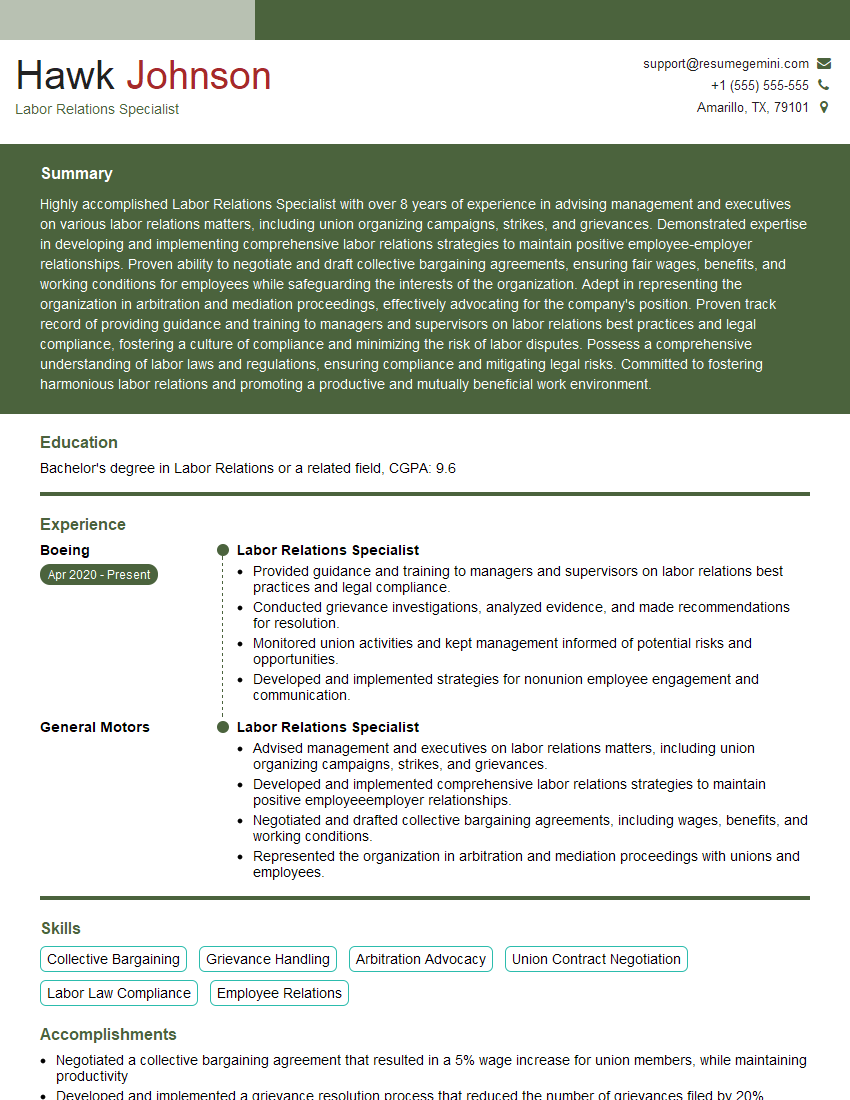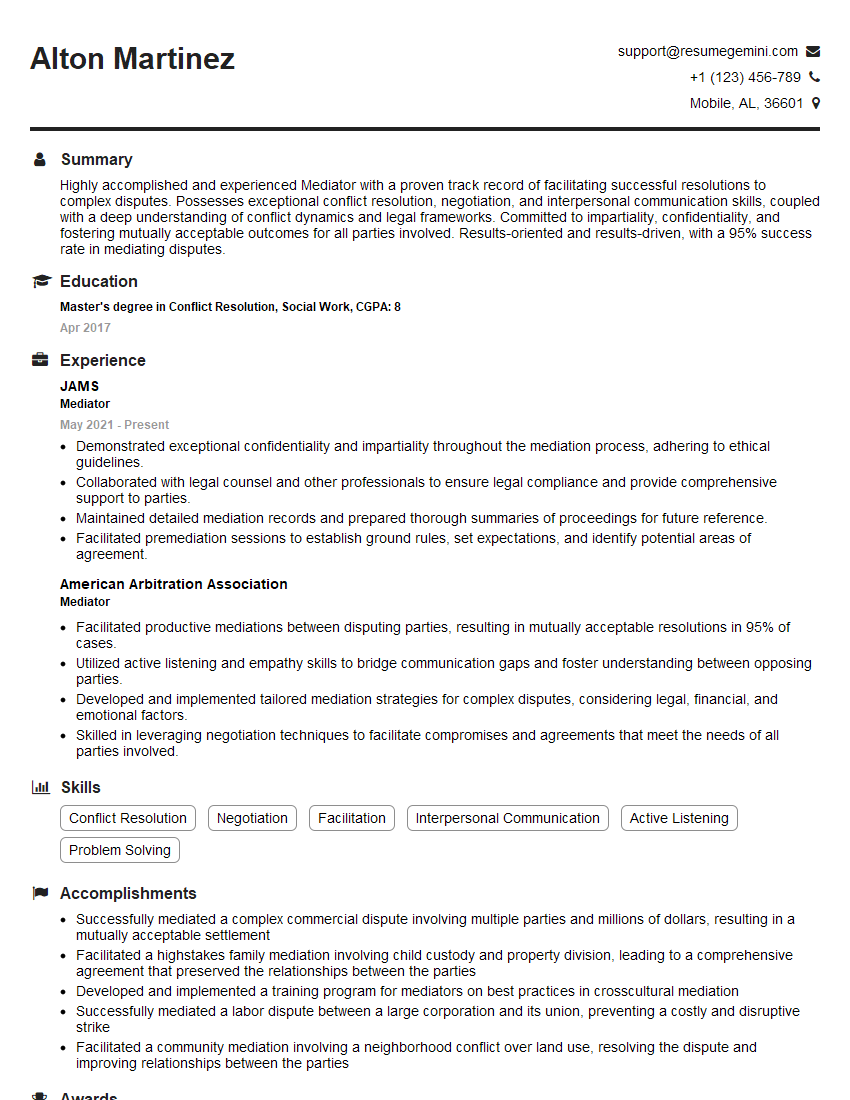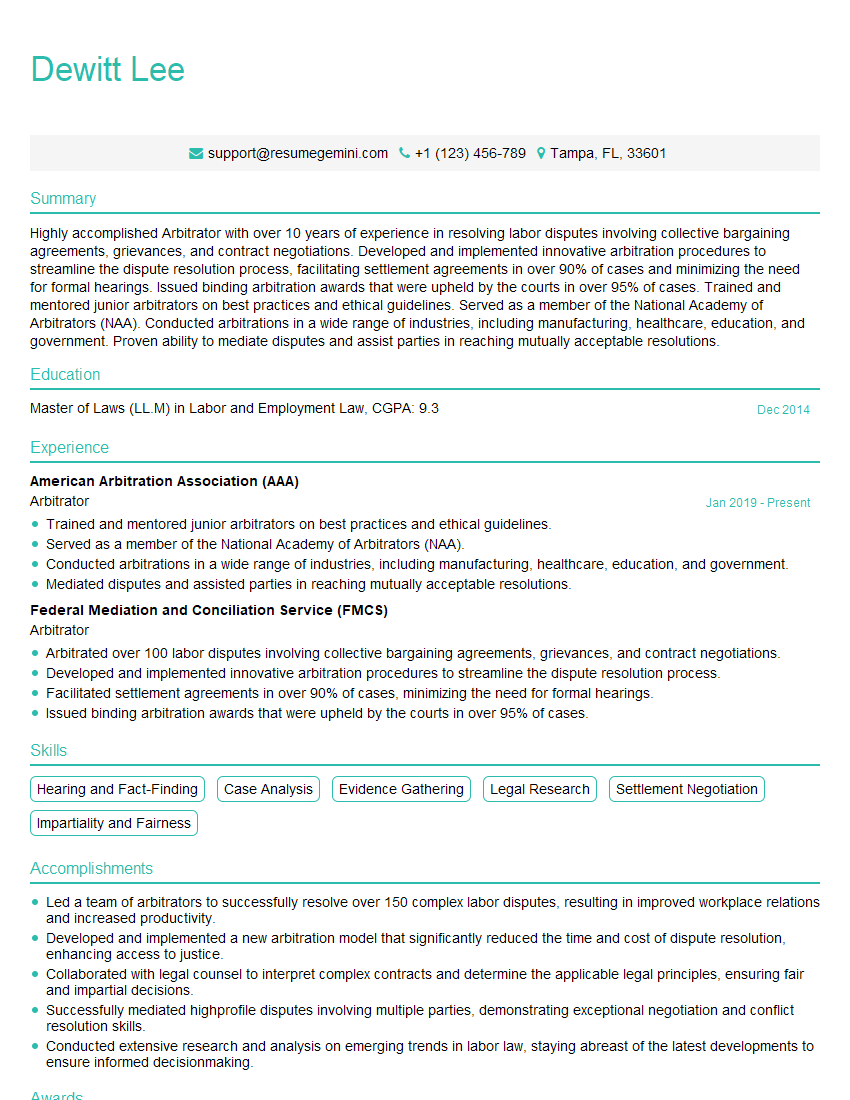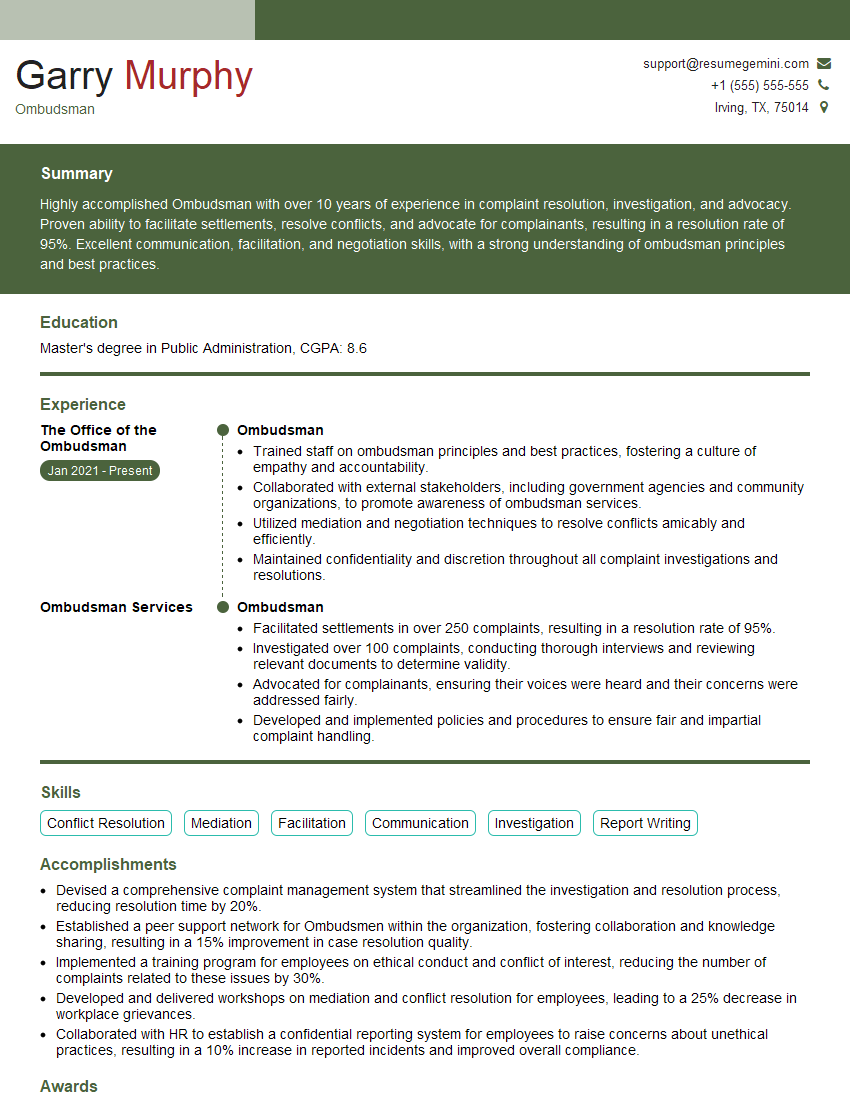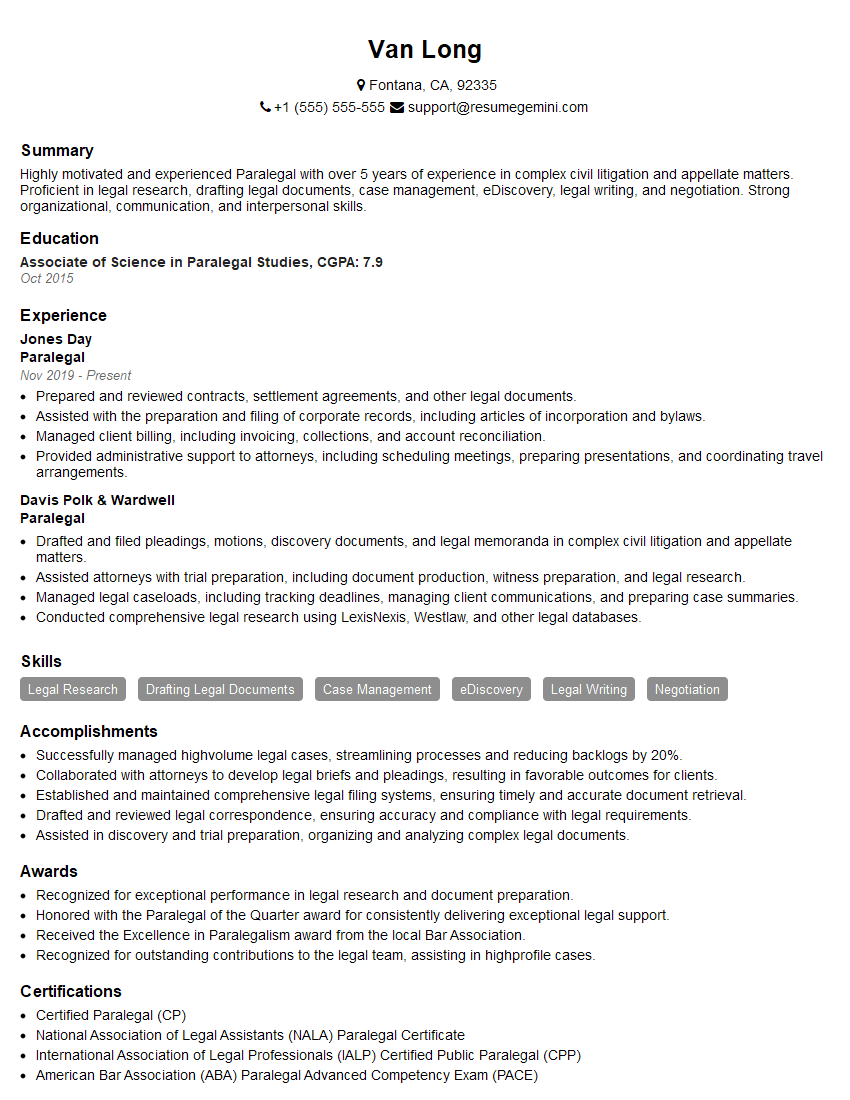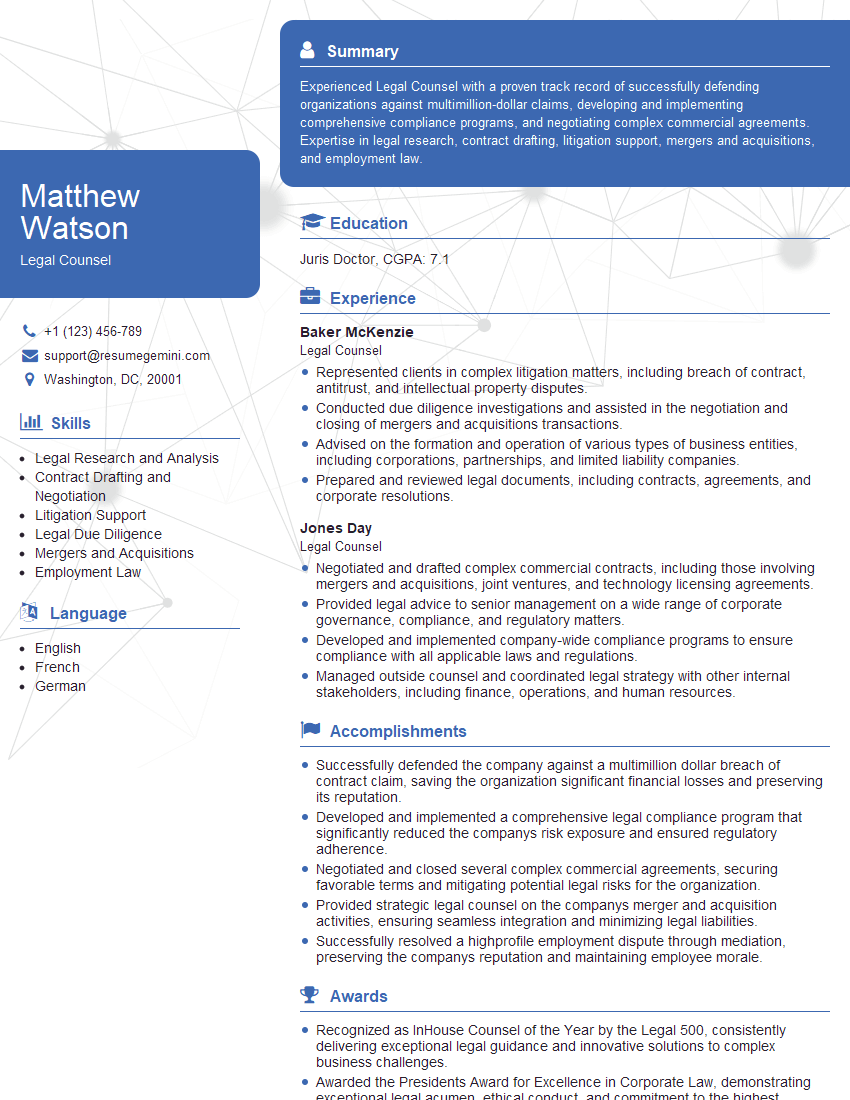Unlock your full potential by mastering the most common Conflict Resolution and Dispute Handling interview questions. This blog offers a deep dive into the critical topics, ensuring you’re not only prepared to answer but to excel. With these insights, you’ll approach your interview with clarity and confidence.
Questions Asked in Conflict Resolution and Dispute Handling Interview
Q 1. Describe your experience mediating disputes between conflicting parties.
My experience in mediating disputes spans over a decade, encompassing a wide range of contexts from workplace disagreements to community conflicts. My approach centers on active listening, fostering a safe space for open communication, and helping parties identify shared interests. I’ve successfully mediated disputes involving everything from contract breaches and property lines to family inheritance battles and workplace harassment claims. In each case, my focus is on guiding the parties towards a mutually agreeable solution, rather than imposing a decision. For example, in one instance involving a landlord-tenant dispute over unpaid rent, I helped the parties uncover underlying issues like unexpected job loss that contributed to the tenant’s financial hardship. This allowed us to collaboratively develop a payment plan that accommodated the tenant’s situation while protecting the landlord’s interests. I always prioritize neutrality, fairness, and confidentiality.
Q 2. Explain your approach to de-escalating a tense situation.
De-escalating tense situations requires a calm and measured approach. My strategy involves several key steps: First, I create a safe and respectful environment. This often involves choosing a neutral location, ensuring physical distance if needed, and using a calm and even tone. Second, I actively listen to each party, validating their emotions without necessarily agreeing with their perspective. This shows empathy and helps them feel heard, a critical step in reducing tension. Third, I employ techniques like rephrasing statements to clarify misunderstandings and focusing the conversation on the issue at hand, rather than personalities. Finally, I help parties identify common goals and explore potential solutions together. For instance, if two colleagues are engaged in a heated argument about project deadlines, I’d guide the discussion away from accusations towards a collaborative problem-solving approach, perhaps brainstorming ways to readjust the timeline to accommodate both sides’ concerns. The goal is to transform a confrontational atmosphere into a collaborative one.
Q 3. How do you identify the root causes of a conflict?
Identifying the root causes of a conflict is crucial for effective resolution. My approach uses a combination of techniques. I begin with open-ended questions to understand each party’s perspective, focusing not just on the immediate event but also on the underlying issues and unmet needs. I look for patterns in their responses, paying attention to recurring themes or emotions. I also consider the context of the conflict, including the relationship between the parties, their history, and the broader organizational or social environment. For instance, a dispute over resource allocation might stem from a deeper issue of perceived unfairness or unequal power dynamics. By carefully examining the narrative of each party and analyzing the overall context, I can identify the underlying causes, allowing for more sustainable solutions. This process helps to address the core problem rather than just treating surface symptoms.
Q 4. What conflict resolution models or theories are you familiar with?
I’m familiar with various conflict resolution models and theories, including:
- Transformative Mediation: Focuses on empowering parties to address their own needs and develop their capacity for future conflict resolution.
- Interest-Based Negotiation (IBR): Emphasizes identifying the underlying interests of each party to find solutions that satisfy everyone’s needs.
- Principled Negotiation (Harvard Negotiation Project): A structured approach that prioritizes separating people from the problem, focusing on interests, generating options, and using objective criteria.
- Restorative Justice: A process that focuses on repairing harm caused by the conflict and involving all stakeholders in the resolution process.
My approach is often integrative, drawing upon elements from these different models depending on the specific context of the conflict.
Q 5. Describe a time you successfully negotiated a compromise.
In a recent project involving a team disagreement over software development methodologies, a heated debate arose between proponents of Agile and Waterfall approaches. Each side strongly defended its preferred method, leading to project stagnation. I facilitated a discussion focusing on each team’s underlying needs and goals. I helped them recognize their shared interest in delivering a high-quality product on time and within budget. By exploring alternative solutions and focusing on compromise, we crafted a hybrid approach that integrated elements of both methodologies. This compromise addressed the key concerns of both teams, leading to a successful project completion and improved team dynamics. The key was not finding a ‘winner,’ but creating a solution that met the core needs of all parties involved.
Q 6. How do you handle individuals unwilling to cooperate?
Handling uncooperative individuals requires patience, persistence, and a flexible approach. I first try to understand the reasons for their resistance. Are they feeling unheard, threatened, or simply distrustful? I then tailor my approach accordingly, employing techniques like active listening, empathy, and reframing to build rapport and trust. Sometimes, offering choices rather than directives can be helpful in engaging reluctant individuals. In cases of continued uncooperativeness, I might involve other stakeholders, such as supervisors or community leaders, to facilitate communication and encourage participation. It’s important to remember that persistence doesn’t mean pressure; it means finding creative and appropriate ways to involve everyone in the process.
Q 7. Explain your understanding of restorative justice principles.
Restorative justice centers on repairing harm caused by conflict and involving all stakeholders in the process. Unlike traditional punitive approaches, it seeks to restore relationships and heal communities. Key principles include:
- Focus on repairing harm: The process prioritizes addressing the needs of victims and restoring what was lost due to the conflict.
- Involvement of all stakeholders: Victims, offenders, and the community are involved in the process to foster dialogue and shared understanding.
- Accountability and responsibility: Offenders are held accountable for their actions, but the emphasis is on making amends and taking steps to prevent future harm.
- Community involvement: The wider community plays a crucial role in supporting the process and fostering reconciliation.
It’s a powerful approach for addressing conflicts that have caused significant harm, fostering healing and strengthening relationships.
Q 8. What are the key elements of a successful mediation session?
A successful mediation session hinges on several key elements, all working in concert to foster a productive and mutually agreeable outcome. Think of it like baking a cake – you need all the right ingredients in the right proportions.
- Neutral Setting and Mediator: A neutral environment, free from distractions and perceived biases, is crucial. The mediator must remain impartial, guiding the process rather than dictating solutions.
- Confidentiality: Participants must feel safe to openly share their perspectives, knowing their communications are confidential. This trust is paramount for effective dialogue.
- Structured Process: A clear and organized structure provides a framework for communication. This might involve opening statements, joint sessions, private caucuses, and a defined process for reaching agreement.
- Active Listening and Empathy: The mediator facilitates active listening, helping each party understand the other’s perspective. Empathy is key to bridging the emotional gap between conflicting viewpoints.
- Focus on Interests, Not Positions: Mediation digs deeper than surface-level arguments. The focus is on uncovering underlying interests and needs, leading to more sustainable solutions. For example, a dispute over parking spaces might reveal underlying concerns about safety or convenience.
- Voluntary Participation and Agreement: Mediation relies on the willing participation of all parties. Any agreement reached must be voluntary and mutually acceptable.
For instance, in a workplace dispute between two colleagues over project responsibilities, a successful mediation would involve a neutral meeting room, a neutral mediator, confidential discussions, a structured process with opening statements and private caucuses, and a focus on uncovering the underlying interests – perhaps one colleague needs more autonomy, while the other needs clearer guidance.
Q 9. How do you ensure fairness and impartiality in conflict resolution?
Ensuring fairness and impartiality in conflict resolution is fundamental to its integrity. It’s about creating a level playing field where everyone feels heard and respected. This requires a conscious and consistent effort on the part of the mediator.
- Equal Opportunity to Speak: Each party must have equal opportunity to express their views, concerns, and evidence without interruption or undue influence.
- Avoiding Bias: The mediator must actively monitor their own biases and ensure they don’t favor one party over another. This involves conscious self-reflection and awareness of potential biases based on personal experiences or societal perspectives.
- Transparency and Consistency: The process must be transparent and consistent, applying the same rules and standards to all participants. Arbitrary decisions or uneven application of rules will undermine fairness.
- Managing Power Imbalances: When a power imbalance exists (e.g., employer-employee), the mediator needs to adopt strategies to level the playing field, ensuring the less powerful party feels empowered to fully participate. This might involve providing additional support or time.
Imagine a mediation between a landlord and tenant regarding rent arrears. Fairness would mean ensuring both parties have ample opportunity to explain their situations, and the mediator doesn’t show favoritism due to the landlord’s perceived greater power. The process must be clear and consistent, applying the same rules of evidence and communication to both sides.
Q 10. How do you document the process and outcomes of a dispute resolution?
Documentation is vital for accountability and preserving the integrity of the conflict resolution process. It provides a record of events, agreements, and any other pertinent information.
- Process Notes: Detailed notes should be taken throughout the process. These notes describe the key discussion points, agreements reached, and any disagreements that remain unresolved.
- Agreements in Writing: Any agreements reached should be documented in writing, signed by all parties, and ideally witnessed by the mediator. This creates a legally binding contract if that is the goal.
- Chronological Record: Maintain a chronological order of events. This allows a clear timeline of events to be created if needed for future reference.
- Confidentiality Considerations: Ensure that all documentation respects the confidentiality agreements made during the mediation process. Names, sensitive information or anything not essential to the main points, may be redacted.
- Record Keeping System: Establish a secure and organized system for storing documents. This might involve a dedicated file system or digital database.
For example, in a family dispute over inheritance, the documentation would include notes from each session detailing the discussions, a written agreement outlining the division of assets, and a record of any outstanding issues.
Q 11. Describe your experience with different conflict resolution styles (e.g., collaborating, competing).
My experience encompasses a range of conflict resolution styles, understanding that the most effective approach depends on the specific context and individuals involved. It’s not about choosing one style exclusively, but rather adapting my approach.
- Collaborating: I’ve extensively used collaborative approaches where the goal is to find a win-win solution that satisfies all parties’ interests. This is often ideal in situations with ongoing relationships, like workplace teams or family matters. For example, helping two departments in a company collaborate on a project by identifying each department’s needs and finding a way to meet them.
- Competing: In situations where one party is clearly violating a legal or ethical standard, a more assertive, competing approach may be necessary to ensure compliance. I would focus on presenting evidence and arguments, not allowing the other party to dominate discussions. This is rare but sometimes appropriate.
- Compromising: This often involves finding middle ground, making concessions to achieve a resolution, although a perfect win-win may not be possible. This can be very effective in time-sensitive situations or when other methods have been unsuccessful.
- Avoiding: Postponing or completely avoiding a conflict is sometimes necessary to allow time for cooling down or gathering information. However, it’s not a sustainable long-term strategy. It’s important to understand when and why this approach is chosen and its limitations.
- Accommodating: This is used in cases where preserving the relationship is prioritized. One party may give in to satisfy the needs of the other even at a personal cost. This is rarely ideal in cases of serious wrongdoing, however.
I adapt the approach based on factors like the nature of the dispute, the parties’ personalities, their power dynamics, and the urgency of the situation. A flexible and adaptable approach is crucial for effective conflict resolution.
Q 12. How do you adapt your approach based on the specific context and parties involved?
Adaptability is the hallmark of a successful conflict resolution practitioner. A ‘one-size-fits-all’ approach is rarely effective. I tailor my approach based on several key contextual factors:
- Cultural Context: Different cultures have differing communication styles and approaches to conflict. Understanding these nuances is vital to building trust and rapport.
- Power Dynamics: Power imbalances require careful attention. Strategies to empower less powerful parties might involve providing support, additional time to formulate responses, and reframing the conversation to focus on shared interests and mutual benefits.
- Personality Differences: Individuals have diverse communication styles and conflict resolution preferences. I adapt my approach to match their styles, ensuring all voices are heard.
- Relationship Dynamics: The existing relationship between parties influences my strategy. In ongoing relationships, preserving the relationship while resolving conflict often becomes a key goal.
- Urgency and Stakes: Time constraints and the importance of the issue influence the pace and approach. A highly urgent matter might require a more direct and efficient process.
For instance, mediating a conflict between business partners requires a different approach than mediating a neighborhood dispute. With business partners, preserving the business relationship is paramount. In a neighborhood dispute, the focus might be more on finding a quick and practical solution to prevent further escalation.
Q 13. How do you handle power imbalances in a conflict?
Power imbalances pose a significant challenge in conflict resolution. They can silence voices, prevent fair participation, and lead to unjust outcomes. Addressing them requires careful strategy:
- Empowering the Less Powerful: I actively create opportunities for the less powerful party to express their concerns fully, without feeling intimidated or silenced. This might involve private caucuses, offering reassurance, and actively challenging any dominance from the more powerful party.
- Leveling the Playing Field: Strategies to level the playing field may include providing resources, information, or expert advice to the less powerful party. I might also frame the discussion to highlight shared interests and goals.
- Building Confidence: Creating a safe and supportive environment is crucial. The goal is to foster confidence and empower the less powerful party to advocate for their needs effectively.
- Focus on Underlying Interests: Delving into the underlying interests rather than the stated positions often reveals common ground. This helps to de-escalate conflict and foster a sense of collaboration.
- Identifying External Resources: If necessary, I might connect parties with external support, such as legal assistance or social services.
For example, in a dispute between an employee and an employer regarding workplace harassment, I would ensure the employee has a safe space to express their experiences without fear of reprisal, providing support and information about their rights and options. I would actively challenge any attempts by the employer to dominate the conversation or downplay the employee’s concerns.
Q 14. What ethical considerations guide your conflict resolution practice?
Ethical considerations underpin my conflict resolution practice. My primary commitment is to fairness, impartiality, and the well-being of all participants. Key ethical guidelines include:
- Impartiality and Neutrality: I maintain impartiality and avoid favoring any party. This includes managing personal biases and ensuring a fair and equitable process for everyone.
- Confidentiality: All communications and information shared during mediation are strictly confidential unless legally required to be disclosed.
- Competence and Professionalism: I only take on cases where I possess the necessary skills and experience to provide effective assistance. I maintain professional standards and conduct at all times.
- Informed Consent: Participants must understand the process, their rights, and the limitations of mediation before engaging in the process. Their voluntary participation is essential.
- Avoiding Conflicts of Interest: I avoid situations that create or could create conflict of interest. This includes disclosing any potential conflicts and refraining from involvement when a conflict exists.
- Respect for Autonomy: I respect the autonomy of each party to make their own decisions. My role is to facilitate a process, not to impose solutions.
These ethical principles guide every aspect of my work, ensuring that the conflict resolution process is both effective and just.
Q 15. How do you manage your own emotions during conflict resolution?
Managing my own emotions during conflict resolution is paramount. It’s like being a calm eye in the storm. I utilize several techniques. Firstly, self-awareness is key. I regularly check in with myself, recognizing my own emotional triggers and biases. This helps me avoid reacting emotionally and instead respond thoughtfully. Secondly, I practice mindfulness and deep breathing exercises to center myself when tensions rise. These techniques help regulate my physiological responses, preventing me from escalating the situation. Thirdly, I actively use emotional regulation strategies like reframing negative thoughts and practicing empathy. For example, instead of feeling frustrated by a party’s stubbornness, I try to understand their underlying concerns and fears. Finally, I believe in self-care; ensuring adequate sleep, exercise, and healthy habits enables me to approach each conflict with emotional resilience.
Career Expert Tips:
- Ace those interviews! Prepare effectively by reviewing the Top 50 Most Common Interview Questions on ResumeGemini.
- Navigate your job search with confidence! Explore a wide range of Career Tips on ResumeGemini. Learn about common challenges and recommendations to overcome them.
- Craft the perfect resume! Master the Art of Resume Writing with ResumeGemini’s guide. Showcase your unique qualifications and achievements effectively.
- Don’t miss out on holiday savings! Build your dream resume with ResumeGemini’s ATS optimized templates.
Q 16. Describe a situation where you had to deal with a difficult or aggressive individual.
I once mediated a dispute between a landlord and a tenant where the tenant was extremely aggressive and verbally abusive. He constantly interrupted, refused to listen to other perspectives, and made personal attacks. My approach involved maintaining a calm and respectful demeanor despite his behavior. I actively listened to his concerns, validating his feelings without condoning his aggressive behavior. I used clear and concise language, setting boundaries firmly yet compassionately. I reiterated the ground rules of the mediation repeatedly, ensuring he understood the consequences of his actions. Gradually, by validating his feelings and focusing on the facts of the case, I managed to de-escalate the situation. We ended up finding a mutually agreeable solution, showcasing the power of empathy even in the face of aggressive behavior. The key was to separate the person from the problem and focus on resolving the underlying issue.
Q 17. How do you facilitate communication and understanding between opposing parties?
Facilitating communication involves creating a safe and neutral space where both parties feel heard and respected. This starts with active listening – truly hearing and understanding their perspectives, not just waiting for your turn to speak. I use techniques like summarizing and paraphrasing to ensure understanding and check for accuracy. I encourage both parties to express their emotions and needs openly, using ‘I’ statements to reduce defensiveness. I also help reframe narratives, moving away from blame and focusing on shared interests and finding mutually acceptable solutions. Visual aids, like mind maps or flowcharts, can be helpful to structure complex information and identify common ground. The process is akin to carefully guiding two ships away from a collision course, ensuring they both understand the others’ navigation.
Q 18. What are the limitations of mediation and when might arbitration be a better option?
Mediation’s limitation lies in its voluntary nature. If one party refuses to participate or cooperate constructively, it’s unlikely to yield a successful outcome. Arbitration is a better option when parties are unwilling or unable to reach a compromise through mediation, or when a legally binding decision is required. For example, in high-stakes commercial disputes or legal battles, arbitration provides a more structured and enforceable resolution mechanism. Mediation excels in fostering collaborative problem-solving, while arbitration offers a quicker, more decisive route when cooperation is lacking. The choice depends on the nature of the conflict, the parties’ willingness to cooperate, and the desired outcome.
Q 19. Describe your experience using different communication techniques during conflict resolution.
My experience spans several communication techniques. I regularly employ active listening, focusing on verbal and non-verbal cues to understand the underlying emotions and concerns. I use reflective listening to summarize and paraphrase, ensuring clarity and demonstrating understanding. When dealing with emotionally charged situations, I leverage empathic listening, validating feelings without necessarily agreeing with the perspective. In situations where parties are entrenched in their positions, I employ transformative communication to help them see the situation from a different perspective and build empathy. Finally, non-violent communication (NVC) is a key tool, helping to articulate needs and requests clearly, fostering understanding and reducing defensiveness.
Q 20. How do you evaluate the effectiveness of your conflict resolution interventions?
Evaluating effectiveness involves both short-term and long-term assessments. Short-term measures include assessing the degree of satisfaction expressed by involved parties immediately following the intervention. Did they feel heard? Do they understand the agreement reached? Long-term evaluation focuses on the durability of the agreement reached. Has the conflict recurred? Have the agreed-upon actions been implemented? I may follow up with the parties after a period to assess their experience and ascertain whether the intervention had a sustained positive impact. Feedback mechanisms, such as surveys or interviews, provide valuable data to inform future interventions and improve my approach.
Q 21. How do you build rapport and trust with conflicting parties?
Building rapport and trust requires establishing a safe and neutral environment. It’s about demonstrating genuine empathy and respect for each party’s perspective, even when you disagree with their viewpoint. Active listening, showing genuine interest in their story, is paramount. I strive to be impartial, avoid judgmental language, and create space for emotional expression. Transparency about the process and its limitations is also crucial. Building trust is a gradual process, requiring consistent demonstration of fairness, impartiality and competence. This resembles the building of any strong relationship; it takes time, effort, and consistent positive interaction. Small acts of consideration can go a long way in building mutual trust and respect.
Q 22. How do you maintain confidentiality during dispute resolution?
Maintaining confidentiality is paramount in dispute resolution. It builds trust, encourages open communication, and protects the parties involved. This is achieved through several key practices.
- Clear Agreements: At the outset, I explicitly state my commitment to confidentiality and obtain informed consent from all parties. This often involves signing confidentiality agreements.
- Secure Communication: I use secure methods for communication, avoiding casual channels like email or social media for sensitive information. I might use encrypted platforms or secure physical storage for documents.
- Limited Information Sharing: I only share relevant information with necessary parties, such as legal counsel or other mediators if applicable, ensuring they also understand and adhere to confidentiality obligations.
- Data Protection: I follow strict protocols for data storage and disposal to prevent unauthorized access or disclosure. This includes secure file storage and responsible disposal of physical documents.
- Professional Boundaries: I maintain strict professional boundaries, refraining from discussing the case details with anyone outside the process. Even casual conversations need to be carefully managed to protect confidentiality.
For example, in a workplace dispute, I would never discuss the specifics of a performance review or a disciplinary action with anyone outside the mediation process, even other colleagues in my organization.
Q 23. Explain your experience with conflict prevention strategies.
Conflict prevention is as crucial, if not more so, than conflict resolution. My approach focuses on proactive measures that reduce the likelihood of disputes arising in the first place.
- Open Communication Channels: Establishing clear and accessible communication channels is fundamental. This might involve regular team meetings, open-door policies, or anonymous feedback mechanisms.
- Clear Expectations and Policies: Ensuring that everyone understands expectations, roles, and responsibilities minimizes misunderstandings. Clear, well-communicated policies regarding conduct and procedures create a framework for behavior.
- Early Intervention: Addressing minor disagreements promptly before they escalate into major conflicts is key. This can involve informal mediation or simply facilitating open communication between the involved parties.
- Training and Development: Equipping individuals with skills in communication, conflict management, and emotional intelligence helps create a more tolerant and understanding work environment.
- Constructive Feedback Mechanisms: Establishing systems for providing and receiving constructive feedback in a safe and respectful manner is crucial. This allows for addressing issues before they snowball into larger disputes.
In a previous role, I implemented a peer mediation program in a school, training students to resolve minor disputes independently. This significantly reduced the number of conflicts that escalated to school administrators.
Q 24. Describe your understanding of the legal framework related to dispute resolution.
A strong understanding of the legal framework is essential for effective dispute resolution. This includes familiarity with relevant laws, regulations, and legal procedures.
- Applicable Laws: I understand the nuances of different legal systems, recognizing which legal principles and statutes are relevant to the specific dispute. This varies greatly depending on the jurisdiction and type of dispute (e.g., contract law, employment law, family law).
- Dispute Resolution Methods: I’m familiar with various dispute resolution methods, including negotiation, mediation, arbitration, and litigation, understanding their strengths, weaknesses, and applicability to different types of disputes. I know when each method is most appropriate.
- Legal Procedures: I’m aware of the procedural requirements of each method, including rules of evidence and the roles of various stakeholders (e.g., judges, arbitrators, mediators). This allows me to guide parties appropriately through the process.
- Legal Representation: I understand the importance of legal representation and advise parties when legal counsel is necessary. I can help them navigate the legal landscape and find suitable legal professionals.
- Ethical Considerations: I am fully aware of ethical obligations concerning legal and professional standards of conduct in dispute resolution, and I uphold the highest levels of professional ethics.
For instance, in a contract dispute, I would be aware of the relevant contract law, the process of presenting evidence, and the potential outcomes based on legal precedent.
Q 25. How do you deal with situations where a resolution cannot be reached?
Reaching a resolution isn’t always possible. When impasse is reached, my focus shifts to managing the situation effectively, even without a complete resolution.
- Acknowledge the Impasse: Openly acknowledging that a full resolution isn’t achievable at this time is important. This avoids creating false hope.
- Identify Remaining Points of Contention: Clearly define the issues that remain unresolved. This provides clarity and potentially highlights areas where compromise is still possible.
- Document the Outcome: Document the process and the points of agreement and disagreement. This provides a record for future reference and may be useful if further attempts at resolution are made later.
- Explore Alternative Options: Explore alternative options, such as arbitration or litigation, explaining the process and potential implications to the parties involved. This gives them control over the next steps.
- Facilitate a Managed Disengagement: If complete resolution is not feasible, help the parties manage their relationship going forward with respectful communication and clear boundaries.
For example, in a long-standing neighborhood dispute, even if a complete resolution concerning property lines is impossible, I might help neighbors develop communication protocols to minimize future conflicts.
Q 26. What are the key performance indicators (KPIs) you use to measure success in conflict resolution?
Measuring success in conflict resolution requires a multifaceted approach. I use several KPIs, both qualitative and quantitative:
- Resolution Rate: The percentage of disputes successfully resolved through negotiated settlements or mediated agreements. This is a simple quantitative measure of success.
- Client Satisfaction: Gathering feedback from clients through surveys or interviews, assessing their level of satisfaction with the process and outcome. This provides qualitative insight.
- Time to Resolution: The average time taken to resolve disputes. This measures efficiency and speed of resolution.
- Cost-Effectiveness: Comparing the cost of the dispute resolution process to the potential costs of litigation or other protracted conflict methods.
- Long-Term Impact: Assessing the long-term impact of the resolution on the relationship between the parties involved. This is often assessed through follow-up interviews.
- Reduced Recidivism: Monitoring whether the same conflicts arise repeatedly after intervention. Low recidivism indicates effective conflict prevention measures.
For instance, a high resolution rate combined with high client satisfaction scores would indicate successful conflict resolution interventions.
Q 27. How do you handle situations involving multiple parties with conflicting interests?
Handling disputes with multiple parties requires a systematic and structured approach.
- Identify Key Players and Interests: Start by identifying all parties involved and understanding their individual interests, needs, and concerns. This includes understanding the power dynamics between parties.
- Structured Communication Protocols: Establish clear communication protocols to ensure everyone has an opportunity to participate and be heard. This may involve rotating speaking time or using specific communication tools.
- Facilitate Collaborative Problem-Solving: Guide the parties towards collaborative problem-solving by focusing on common goals and shared interests. This can involve brainstorming sessions or joint problem-solving exercises.
- Prioritize and Manage Issues: Organize the issues in a logical sequence, focusing on the most critical and readily solvable points first. This avoids overwhelming the group with complex issues early on.
- Develop a Multi-Party Agreement: Work towards a comprehensive agreement that addresses the needs and concerns of all parties. This requires careful consideration of trade-offs and concessions.
For example, in a community dispute over a park development project, I would facilitate a series of meetings with residents, the developers, and local government representatives to find a solution that meets the needs of all stakeholders.
Q 28. Describe your experience with conflict resolution in diverse cultural settings.
Cultural sensitivity is crucial in conflict resolution. My experience working in diverse cultural settings has taught me the importance of understanding and adapting to different communication styles, values, and conflict resolution approaches.
- Cultural Awareness: I actively seek to understand the cultural backgrounds and values of all involved parties. This may involve researching cultural norms or directly asking individuals about their cultural preferences.
- Adaptable Communication Styles: I adjust my communication style to be appropriate for the cultural context. This might involve adapting my language, tone, and nonverbal cues.
- Respect for Cultural Differences: I demonstrate respect for different perspectives and worldviews. This involves actively listening and showing empathy toward individuals from different cultural backgrounds.
- Appropriate Conflict Resolution Strategies: I adapt my conflict resolution strategies to be culturally appropriate. Some cultures favor direct confrontation, while others prioritize mediation and indirect approaches.
- Collaboration with Cultural Experts: When necessary, I seek the advice and collaboration of cultural experts or interpreters to ensure effective cross-cultural communication and conflict resolution.
For example, in a business negotiation involving parties from different countries, I would be mindful of their varying communication styles and adapt my approach accordingly. I might involve a translator if necessary and be sensitive to differing levels of formality and directness.
Key Topics to Learn for Conflict Resolution and Dispute Handling Interview
- Understanding Conflict Dynamics: Explore different conflict styles (e.g., competing, collaborating, compromising), conflict escalation stages, and the underlying interests driving disputes.
- Communication & Active Listening: Master techniques for effective communication, including active listening, empathy, and non-violent communication, crucial for de-escalation and finding common ground.
- Negotiation & Mediation Strategies: Learn various negotiation approaches (e.g., principled negotiation, integrative bargaining) and mediation techniques to facilitate constructive dialogue and mutually acceptable solutions.
- Conflict Prevention & Early Intervention: Understand proactive strategies to prevent conflicts from arising and techniques for early intervention to manage minor disagreements before they escalate.
- Ethical Considerations & Legal Frameworks: Familiarize yourself with ethical guidelines in conflict resolution and relevant legal frameworks impacting dispute handling processes.
- Practical Application: Case Studies & Role-Playing: Prepare examples from your experience (or hypothetical scenarios) demonstrating your application of conflict resolution skills in various settings. Practice role-playing different conflict scenarios.
- Cultural Sensitivity & Diversity: Recognize how cultural differences and individual backgrounds influence conflict styles and adapt your approach accordingly.
- Assessment & Evaluation of Outcomes: Understand methods for assessing the effectiveness of conflict resolution strategies and evaluating the long-term impact of resolutions.
Next Steps
Mastering Conflict Resolution and Dispute Handling is invaluable for career advancement across numerous fields. These skills are highly sought after, demonstrating your ability to build strong relationships, navigate complex situations, and drive positive outcomes. To enhance your job prospects, create a compelling and ATS-friendly resume that highlights your expertise. ResumeGemini is a trusted resource to help you craft a professional and impactful resume showcasing your unique skills and experience. Examples of resumes tailored to Conflict Resolution and Dispute Handling are available to guide you. Invest in your future and build a resume that truly reflects your capabilities.
Explore more articles
Users Rating of Our Blogs
Share Your Experience
We value your feedback! Please rate our content and share your thoughts (optional).
What Readers Say About Our Blog
good



